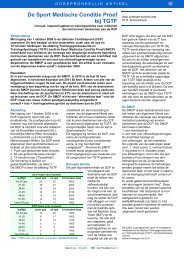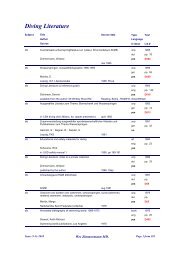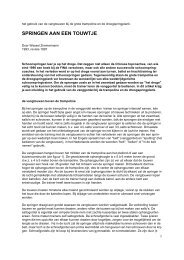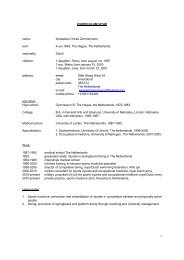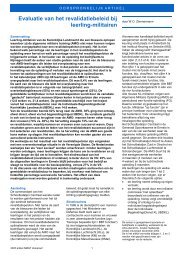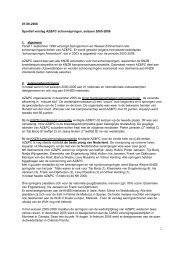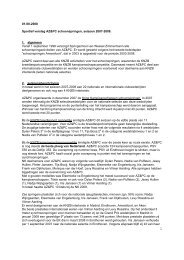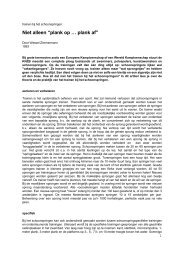The Dutch Diving Fitness Test; - Wessel Zimmermann - Amersfoort
The Dutch Diving Fitness Test; - Wessel Zimmermann - Amersfoort
The Dutch Diving Fitness Test; - Wessel Zimmermann - Amersfoort
- No tags were found...
You also want an ePaper? Increase the reach of your titles
YUMPU automatically turns print PDFs into web optimized ePapers that Google loves.
Wetenschappelijk onderzoekTable 5a: test item 11 replaces test item 5, midway in the study, September 2006Item Title Description11 Hanging tuck ups<strong>The</strong> diver is hanging by the arms on a bar; the feet are off the ground. <strong>The</strong> diver lifts both kneestowards the chest. A helper prevents swinging; repetitions in 20 seconds.(Figure 10 + 11)Reason: represents strength of the hip flexor muscles.Measurement error: poorly executed repetitions (hip flexion less then 100°) do not count.Figure 6 test item 6, back extensions startFigure 7 test item 6, back extensions middle positionTable 5b: test item 11: average and standard deviations of measurement values.girls boysage 7 8+9 10+11 12+13 8+9 10+11 12+13item 11 16.1 ± 2.3 16.6 ± 3.5 16.1 ± 2.5 16.9 ± 2.1 15.1 ± 3.9 18tuck ups n = 0 n = 48 n = 38 n = 7 n = 20 n = 15 n = 1Photo 8 test item 7, stand and reachFigure 10 test item new, hanging tuck ups startFigure 9 test item 8, shoulder flexibility (prone).Figure 11 test item new, hanging tuck ups, middle positionTable 6: Conversion table for the proposed <strong>Dutch</strong> <strong>Diving</strong> <strong>Fitness</strong> <strong>Test</strong>, 2008. <strong>Test</strong> item 5 is “hanging tuck ups”test item girls 8 + 9 girls 10 + 11 boys 8 + 9 boys 10 + 11 test pointsitem 1 131 and < 140 and < 131 and < 142 and < 5height 132-133 141-144 132-133 143-144 4cm 134-135 145 134-137 144-145 3136-137 146-148 138-139 146-147 2138-140 149-150 140-141 148 1item 2 27 and < 31 and < 26 and < 33 and < 5weight 28 32-34 27-28 34 4kg 29 35 29-30 35 330 36-37 31 36 231 38-39 32 37-38 1item 3 5 and < 5 and < 4.5 and < 7 and < 5toe point 5.5 5.5-6 5 7.5 46 6.5 5.5-6 8 36.5 7 6.5 8.5 27 7.5-8 7-7.5 9 1item 4 19 and > 19 and > 20 and > 20 and > 5push ups 17-18 18 19 19 4from knees 16 15-17 18 18 320 sec 15 14 16-17 17 214 13 15 16 1item 5 19 and > 20 and > 20 and > 19 and > 5hanging 18 19 19 18 4tuck ups 17 18 18 17 320 sec 16 17 17 16 215 16 16 15 1item 6 19 and > 19 and > 20 and > 20 and > 5back 18 18 19 19 4extensions 17 17 18 18 320 sec 16 16 17 17 215 15 16 16 1item 7 10 and > 9 and > 7 and > 6 and > 5stand 7-9 7-8 4-6 2.5-5 4 Sport & Geneeskunde | mei 2009 | nummer 2 nummer 2 | mei 2009 | Sport & Geneeskunde
Wetenschappelijk onderzoekand 6 5-6 3 2 3reach 4-5 4 2 1.5 23 3 1 1 1test item girls 8 + 9 girls 10 + 11 boys 8 + 9 boys 10 + 11 test pointsitem 8 35 and > 38 and > 35 and > 37 and > 5flexibility 30-34 35-37 30-34 32-36 4in shoulders 29 32-34 28-29 30-31 328 30-31 25-27 29 226-27 29 24 27-28 1item 9 164 and > 169 and > 171 and > 182 5long jump 157-163 162-168 162-170 180-181 4150-156 158-161 156-161 175-179 3145-149 152-157 152-155 169-174 2141-144 148-151 150-151 160-168 1item 10 10.71 and < 10.43 and < 10.4 and < 9.95 and < 54x10 meter 10.72-10.94 10.44-10.67 10.41-10.73 9.96-10.21 4sprint 10.95-11.26 10.68-10.88 10.74-10.85 10.22-10.53 311.27-11.44 10.89-11.13 10.86-10.94 10.54-10.60 211.45-11.62 11.14-11.28 10.95-11.04 10.61-10.94 1Table 7: Interpretation guide for the total test score on the DDFT: percentile scores per age and per gender.age n P 90P 80P 70P 60P 50girls 8+9 66 28 22 20 18 16girls 10+11 70 27 22 17 15 13boys 8+9 32 25 22 18 15 13boys 10+11 20 25 21 20 15 12interpretation top 10% top 20% top 30% top 40% top 50%Discussion<strong>The</strong> goal of this study was to define the normal rangesfor <strong>Dutch</strong> schoolchildren on a test battery for springboarddiving. Table 6 shows the results for ten test items.This table can be used by diving coaches to convertmeasurement scores into a total fitness score for novicedivers. Table 7 can be used by the test administrator tointerpret the total test score.Eight test items were taken from an existing (Mexican)test. One test item was altered, pull ups were exchangedfor push ups. Two test items, body height and bodyweight, were added to the test, because they are oftenused in other diving fitness tests. <strong>The</strong>re is evidence thatbody size matters in achieving success in diving 8,9 andother acrobatic sports.10 Most test items used are commonexercises in many other sports. <strong>The</strong>refore, the resultsof this study may be of interest to professionals whotest children in other (acrobatic) sports.In this study the majority of the tested children are girls.This reflects the state of the sport in <strong>The</strong> Netherlands:two-third of the club members is female. Although thediving introduction course is open to children ages 7-13,only few children in the ages of seven, twelve and thirteenparticipated in the four seasons of this study. In othercountries children are tested for diving fitness at six oreven five years of age. It takes on average 10 years tobecome a participant at the international senior level andoften longer to become an international champion10.<strong>The</strong> collection of measurement values for beginning<strong>Dutch</strong> divers ages six and seven seems warranted. Thisis, however, not easy. First, the DDFT has been adminis-tered to a few 6-year old club divers. Explaining the correctexecution of the test items to children of this age isdifficult. It takes patience and extra attempts at testitems for the test administrator to obtain reliable measurements.Second, <strong>Dutch</strong> parents rarely bring their childrento diving lessons before the age of 8.For test items 4, 5 and 6 respectively, less measurementvalues have been presented than for some of the othertest items (Table 4). This is because these test items requirean interpretation by the test administrator of thenumber of correctly performed repetitions. In a numberof cases the test administrators indicated doubt on theexact number of correct repetitions. In these cases themeasurement values were disregarded. In this study thetest administrators were instructed in uniform scoringrepetitively, but no attempt was made to quantify testretestreliability and inter-administrator consistency.<strong>Test</strong> item 5, semi-pike ups, was found to be the mostdifficult exercise to perform correctly for the novice divers,because of a lack of hamstring flexibility. <strong>Test</strong> item5 was replaced by test item 11, hanging tuck ups. Thisitem tests a similar action of the body (hip flexion), butis less influenced by hamstring flexibility of the diver.Table 6 has been compared to the conversion table thatcame with the original test from Mexico. <strong>The</strong> followinggeneralisations can be made: <strong>Dutch</strong> children score betteron test item 10 (4x10 meter sprint) and score muchworse on test item 7 (stand and reach) and test item 8(shoulder flexibility). In many of the other test items,smaller differences were present. Overall, Table 6 isquite different from the Mexican conversion table. Thisconfirms the necessity of the current study.All test items receive a possible five points. Most divingcoaches find some test items more important thanothers. This is because they assume that there is a timewindow of opportunity to train children on motor abilities.For example, the best time to increase flexibilityis between five and eight years old. 11 In the selectiontest of former East Germany divers who showed deficienciesin some test items could still be accepted intothe elite training program. Low scores on the test itemsfor flexibility however automatically led to rejection 2 .Other coaches consider the ability to jump the mostimportant test item. 12 To interpret the final test score ofchildren tested in the DDFT, coaches should not onlystudy the total test score, but also the results on all tentest items separately.<strong>The</strong> number of divers selected for a team depends notonly on the performance of the diver on the selectiontests, but also on the number of training places available.If the number of places is limited and the number ofchildren trying out is very large, only the very best areaccepted. 1 If the diving club uses a testing scheme togain new members, more than 25% of the tested childrenare invited to join the club. 2 In the city of <strong>Amersfoort</strong>,children with 25 points out of 50 on the DDFT are invitedto join the club selection of “competition trainees”,others are referred to recreational diving classes. Settingthe standard at 25 points brings for this club theright balance between adequate fitness of the beginningdiver for the training program and the number of placesin the intensified training group.It is a common mistake to confuse a fitness test for atalent identification procedure. Current best practice inthe complex field of talent identification emphasizesthat fitness testing is only a part of a talent “confirmationprocess” that should last at least 3-6 months. 13 Itis interesting to note that in the sport of competitivediving successful nations use such a modern talentidentification process already for more than 20 years(Table 1). 2,4,5It is impossible to scientifically prove the predictive valuefor diving success of the DDFT in a comparative study.Selected and non-selected divers do not receive thesame training opportunities. It can therefore not be determinedwhether children with a low score on the DDFTcan reach the same standard of diving as children witha high score on the DDFT. A possible way of evaluatingthe DDFT is by looking at the success of the divers thathave been selected with the DDFT in a few years fromnow. This strategy was used in two studies 8,9 . In the formerSoviet Union, 59 factors were evaluated on theirpredictive power for diving success during a three yearperiod: 1977 through 1980. <strong>The</strong> following factors werestatistically different in successful divers: height, weight,chest circumference, shoulder width, calf circumference,vertical jump and hanging pike-ups.8 In the United States,121 boys and 151 girls participating in the juniorOlympic diving festivals of 1991 and 1992 were tested onmultiple items. Ten years later it was evaluated which of Sport & Geneeskunde | mei 2009 | nummer 2 nummer 2 | mei 2009 | Sport & Geneeskunde 10
Wetenschappelijk onderzoekAbout the author<strong>Wessel</strong> O. <strong>Zimmermann</strong>, drs.,geregistreerd sportarts enbedrijfsartsTrainingsgeneeskunde enTrainingsfysiologie, KoninklijkeLandmacht, locatie Utrecht.Wes <strong>Zimmermann</strong> (1964) is aphysician specializing in therehabilitation of sport and workrelated injuries. He is employed bythe Royal <strong>Dutch</strong> Army in thedepartment of Sports Medicine andExercise Physiology. He is also aformer international diver (1978-1991) and current age group divingcoach, responsible for the regionaldiving center <strong>Diving</strong> <strong>Amersfoort</strong>,in <strong>The</strong> Netherlands. Wes<strong>Zimmermann</strong> is six time “nationaldiving coach of the year” (2003-2008). His best placed diverachieved 9th in the 2006 worldjunior championships on the 10-meter platform, in the categorygirls 16-18.Correspondence:wesselzimmermann@hotmail.comStille Steeg West 343823 ZJ <strong>Amersfoort</strong>Telefoon: 06-51163409these successful junior divers became successfulsenior divers. Statistically significant factors forgirls were: a start in gymnastics, small and lightposture, late menarche, less fat and more muscle.Important factors for boys were: the scoreson sit ups, sit and reach and a quadrant jump.9 Asimilar evaluation of the DDFT in the future couldlead to a weighted scoring system, in which sometest items receive more than five points, othersless, based on their predictive power for divingsuccess.Conclusions<strong>The</strong> <strong>Dutch</strong> <strong>Diving</strong> <strong>Fitness</strong> <strong>Test</strong> is a practical toolto test physical performance of novice divers.<strong>The</strong> test is used to guide divers to the appropriatetraining group, recreational or competitive.Four hundred and forty two <strong>Dutch</strong> schoolchildrenwere tested on 10 test items to define the normalranges of this test. <strong>The</strong> results of this study arenot only relevant to those who work in the field ofspringboard and platform diving, but may be relevantto professionals who test children in other(acrobatic) sports.Literature1. <strong>Zimmermann</strong> WO. Schoonspringen in Mexico: een andereschoonspringwereld.In: KNZB Almanak Schoonspringen. KNZB, Nieuwegein,2001;147-151.6. Kerr R. Talent identification for competitive diving. Presentedat: Canadian society for motor learning and sports psychology.November 1978, Toronto.7. Danilov K. Basics of coaching diving. Moscow: Institute forphysical education and sports, 1969.8. Baensch K. Ergebnisse zur Vervollkommnung der Eigningsdiagnostikim Wasserspringen. <strong>The</strong>orie und Praxis Leistingssport1984;22(5):99-110.9. Malina RM. Successful divers: characteristics of junior Olympicparticipants.Inside USA <strong>Diving</strong> 2001;9(4):3,6-7.10. Wolstencroft E. Talent identification and development: anacademic review. Edinburgh: Sportscotland, 2002.11. Malina RM. Growth, maturation and development. In: MalinaRM (ed). USA <strong>Diving</strong> coaches development reference manual.Indianapolis: USA <strong>Diving</strong>, 2007, 3-29.12. Nickel U. Die Bedeutung motorischer Grundfaehigkeiten fürdie Talentauswahl am Beispiel des Wasserspringens. In: DieTalentproblematik in Sport, Bonn: Deutsche Vereinigung fürSportwissenschaft, 1988;30:136-139.13. Vayens R, Lenoir M, Williams AM, Philippaerts RM. Talentidentification and development programmes in sport. Currentmodels and future directions. Sports Med 2008; 38(9):703-714.2. Distelrath A. Versuch einer systematischen Trainingsgestaltungim Wasserspringen; Diplomarbeit. Universität Köln, 1992.3. Coaching Level III. Ottawa: Canadian Amateur <strong>Diving</strong>Association (CADA), 1987;521-531.4. Gil JM. Programma de evaluacion y control del desarrollo desaltadors. In: Saltos. Madrid: Royal Spanish SwimmingFederation (RFEN), 1998;20-34.5. Wingfield JV. <strong>The</strong> Chinese way: selection of young divers, part I.Inside USA <strong>Diving</strong> 2007;15(1):14-15.11 Sport & Geneeskunde | mei 2009 | nummer 2




